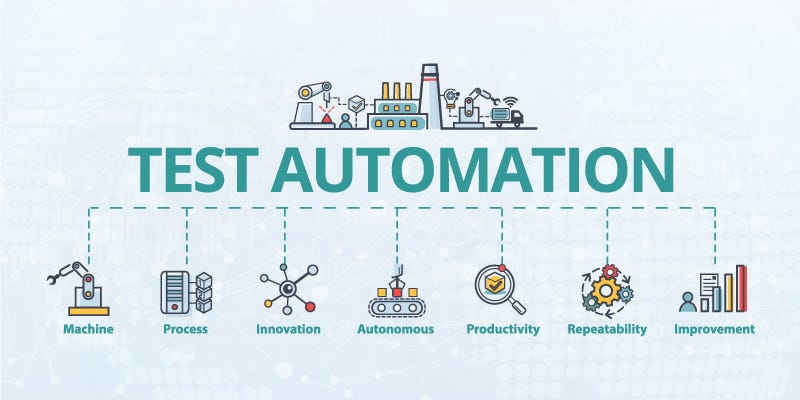Automation Testing Structures: Streamlining Intricate Testing Circumstances
Automation Testing Structures: Streamlining Intricate Testing Circumstances
Blog Article
Making Certain Success in Automation Evaluating: Trick Metrics, Challenges, and Solutions Every QA Group Should Know
In the world of software program high quality guarantee, the landscape of automation testing is ever-evolving, demanding a thorough method to make certain seamless procedures. Key metrics work as the compass assisting QA groups through the large surface of examination automation, clarifying development and locations for improvement. However, challenges loom big, typically casting shadows on the course to success. By recognizing these difficulties and executing efficient remedies, QA groups can browse via complexities with finesse. The journey to grasping automation screening is led with subtleties that need an eager eye for monitoring, analysis, and continual renovation. automation testing. As the industry moves forward, the quest for optimal performance in automation testing remains a constant pursuit, urging QA teams to equip themselves with the knowledge and techniques vital for victory.
Relevance of Secret Metrics
Comprehending the importance of key metrics is crucial for examining the efficiency and performance of automation screening processes. Trick metrics act as measurable procedures that offer important understandings into various facets of the screening process, such as test insurance coverage, test implementation time, problem thickness, and test situation efficiency. By assessing these metrics, QA teams can recognize bottlenecks, inefficiencies, and areas for enhancement within their automation screening framework.
One crucial element of key metrics is their capability to track progress and keep an eye on the general health of the testing procedure (automation testing). They enable stakeholders to make enlightened decisions based upon data-driven understandings, which can cause much more reliable testing techniques and far better resource allotment. In addition, crucial metrics can help teams set practical goals, determine the success of automation campaigns, and show the ROI of automation screening efforts

Usual Difficulties Faced
Challenges frequently experienced in automation testing procedures can substantially impact the total effectiveness and effectiveness of QA teams. One of the significant challenges is the option of the ideal test instances for automation. Not all test cases appropriate for automation, and selecting the wrong ones can bring about lost time and sources. Furthermore, maintaining examination scripts can be a daunting job, especially as the application undertakes frequent adjustments. Test script maintenance requires continuous updates and alterations to ensure they show the existing performance properly. Another usual challenge is the preliminary financial investment needed for establishing automation frameworks and tools. This can be an obstacle for some companies, particularly smaller sized ones with limited budget plans. Furthermore, automation testing may not cover all facets of testing, such as functionality and customer experience testing, which still need hand-operated intervention. Conquering these obstacles requires proper planning, critical test situation choice, durable upkeep procedures, adequate resources, and a clear understanding of the you could try these out restrictions of automation screening.
Effective Solutions for Difficulties
To resolve the barriers run into in automation testing, implementing effective solutions is crucial for improving the effectiveness my sources and productivity of QA groups. One vital solution is to purchase durable training programs for QA teams to ensure they have the essential skills to effectively make use of automation devices. Training can link understanding gaps, boost understanding of automation frameworks, and boost scripting abilities, ultimately causing extra effective test development and execution.
An additional important remedy is to establish clear interaction channels within the QA group and with other stakeholders, such as programmers and job supervisors. Effective interaction helps in aligning assumptions, sharing progress updates, and without delay attending to issues or obstacles that might occur throughout the automation screening process.

Tracking and Analysis Techniques
Carrying out effective surveillance and analysis methods is essential for making certain the success and efficiency of automation screening procedures. Additionally, examining examination outcomes and metrics offers beneficial insights into the top quality of the software program being evaluated and the efficiency of the screening method.
One key technique in tracking and evaluation is making use of dashboards that combine pertinent metrics and KPIs in an aesthetically accessible layout. These control panels offer a thorough overview of test execution condition, examination protection, issue trends, and other vital info. Regularly evaluating and examining these control panels can assist QA teams make informed decisions, prioritize tasks, and optimize testing efforts.
Additionally, executing automated informs and alerts based on predefined thresholds can boost aggressive surveillance and prompt treatment. By establishing signals for efficiency inconsistencies or examination failings, teams can deal with issues promptly and prevent them from escalating. On the whole, surveillance and analysis techniques play a vital role in guaranteeing the performance and success of automation screening initiatives.
Continuous Improvement Approaches
Enhancing the efficiency of automation testing procedures necessitates the constant improvement of approaches and approaches. One crucial approach to improving automation Recommended Site screening processes is to carry out normal reviews and retrospectives.

Conclusion
To conclude, it is important for QA groups to comprehend the key metrics, obstacles, and services in automation screening to guarantee success. By carefully checking and examining information, carrying out reliable services to usual difficulties, and continually improving methods, QA teams can maximize their testing procedures and supply premium software. Abiding by these techniques will eventually bring about more effective and reliable automation screening practices.
By examining these metrics, QA groups can identify bottlenecks, inadequacies, and areas for renovation within their automation screening framework.
Furthermore, key metrics can assist groups established realistic objectives, measure the success of automation campaigns, and demonstrate the ROI of automation testing initiatives.
Obstacles typically run into in automation screening procedures can significantly affect the total effectiveness and efficiency of QA teams. Automation testing may not cover all elements of testing, such as usability and individual experience testing, which still require hands-on intervention.In final thought, it is important for QA teams to recognize the essential metrics, obstacles, and options in automation testing to ensure success.
Report this page